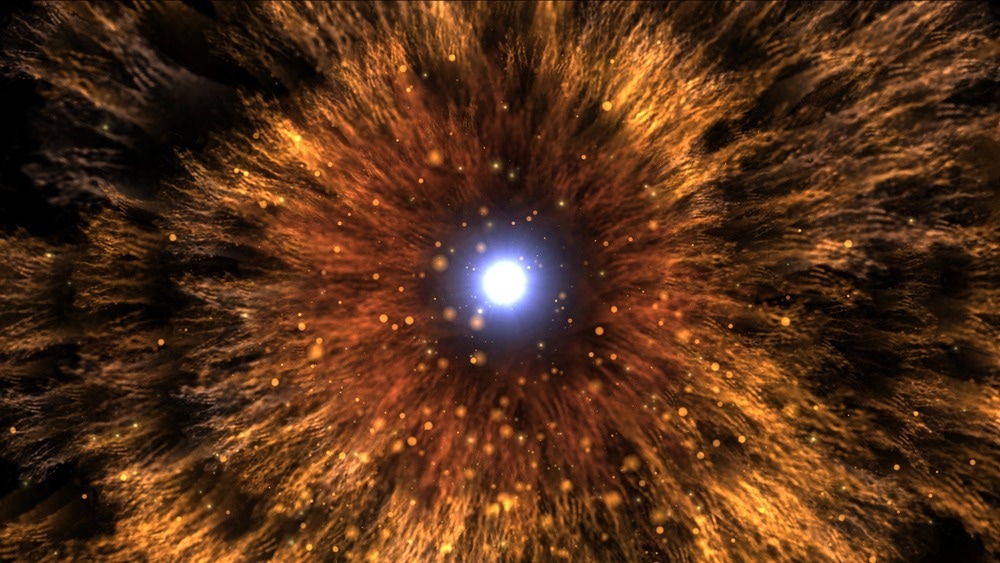In a new research study, scientists have taken a vital step toward comprehending how exploding stars can aid in showing how neutrinos, cryptic subatomic particles, communicate with themselves secretly.

Image Credit: Antrakt2/Shutterstock.com
One of the less well-studied elementary particles, neutrinos hardly interact with normal matter, and instead invisibly travel through it at nearly the speed of light. These supernatural particles can be more than all the atoms present in the universe and are constantly passing harmlessly via human bodies—but owing to their lack of an electric charge and low mass, they can be extremely challenging to find and study.
However, in a study published in the journal Physical Review Letters, scientists at The Ohio State University have established a novel framework explaining how supernovae, which are enormous explosions that herald the death of collapsing stars, could be employed as efficient tools to learn how neutrino self-interactions can make massive cosmological alterations in the universe.
Neutrinos only have very small rates of interaction with typical matter, so it’s difficult to detect them and test any of their properties. That’s why we have to use astrophysics and cosmology to discover interesting phenomena about them.
Po-Wen Chang, Study Lead Author and Graduate Student, Physics, Ohio State University
Although having found that they originate from numerous sources, such as in nuclear reactors or the interior of dying stars, neutrinos are believed to have been crucial to the creation of the early universe and still being mysterious to scientists.
Nevertheless, by quantifying how self-interactions would impact the neutrino signal from Supernova 1987A, the nearest supernova noticed in modern times, scientists discovered that when neutrinos do communicate with themselves, they develop a tightly coupled fluid that enlarges under relativistic hydrodynamics—a branch of physics that involves how flows affect solid objects in either of two varied ways.
In the scenario of what is known as a “burst outflow,” the team theorizes that it is similar to popping a highly pressurized balloon in the vacuum of space would push energy outward; a burst generates a neutrino fluid that travels in every direction. The second scenario, explained as a “wind outflow,” envisions a highly pressurized balloon with multiple nozzles, wherein neutrinos escape at a more constant flow rate, just as to a jet of steady wind.
Chang stated that although the wind-outflow theory is more possibly to occur in nature if the burst case is recognized, researchers could observe novel observable neutrino signatures released from supernovae, facilitating unparalleled sensitivity to neutrino self-interactions.
One of the reasons it is so important to comprehend such mechanisms is whether neutrinos are serving as a fluid, which implies they are acting collectively or together. And, whether the properties of neutrinos are varied as a unit than separately, then the supernovae physics could experience modifications as well. Nevertheless, if such changes are due exclusively to the burst case or the outflow case remains to be noticed.
“The dynamics of supernovae are complicated, but this result is promising because with relativistic hydrodynamics we know there’s a fork in the road in understanding how they work now,” stated Chang.
Still, more studies have to be done before researchers can cross off the potential of the burst case occurring within the supernovae too.
Despite these reservations, the research is a great milestone in addressing the decades-old astrophysical concern of how neutrinos disperse when released from supernovae, stated John Beacom, co-author of the study and a professor of physics and astronomy at Ohio State.
This research discovered that in the burst case, unparalleled sensitivity to neutrino self-interactions is likely even with sparse neutrino data from SN 1987A and traditional analysis expectations.
“This problem has lain basically untouched for 35 years. So even though we were not able to completely solve how neutrinos affect supernovae, what we’re excited about is that we were able to make a substantial step forward,” stated Beacom.
Going road, the team believes their work will be utilized as a first step in further examining neutrino self-interactions. Still, as only around two or three supernovae occur every century in the Milky Way, scientists will need to wait several more years to gather sufficient new neutrino information to demonstrate their notions.
We’re always praying for another galactic supernova to happen somewhere and soon, but the best we can do is try to build on what we know as much as possible before it happens.
Po-Wen Chang, Study Lead Author and Graduate Student, Physics, Ohio State University
Ivan Esteban, Todd Thompson, and Christopher M. Hirata, all of Ohio State are the other co-authors. This study was funded by the National Science Foundation, NASA, and the David & Lucile Packard Foundation.
Journal Reference:
Chang, P-W., et al. (2023) Toward Powerful Probes of Neutrino Self-Interactions in Supernovae. Physical Review Letters. doi.org/10.1103/PhysRevLett.131.071002.